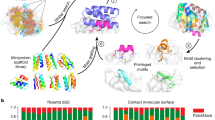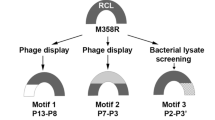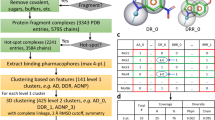Abstract
Current approaches to enzyme specificity focus on the identification of consensus sequences from combinatorial chemistry libraries or phage display. These synthetic substrates can also be used as sensitive probes for the molecular environment of the enzyme specificity sites to determine how they contribute to recognition in the transition state. Libraries constructed to include all relevant species for a site-specific analysis contain a relatively small number of substrates and provide quantitative information on the energetics of recognition that can be exploited in studies of structure-function relations and rational drug design. We have constructed a library of substrates carrying substitutions at P1, P2, and P3 to probe the response of the specificity sites S1, S2, and S3 of thrombin. The library has been used to identify differences between the anticoagulant slow and procoagulant fast forms of thrombin and the structural origin of the effects. The results also offer new guidelines for the design of active-site inhibitors of thrombin.
This is a preview of subscription content, access via your institution
Access options
Subscribe to this journal
Receive 12 print issues and online access
$209.00 per year
only $17.42 per issue
Buy this article
- Purchase on Springer Link
- Instant access to full article PDF
Prices may be subject to local taxes which are calculated during checkout
Similar content being viewed by others
References
Wells, J.A. 1990. Additivity of mutational effects in proteins. Biochemistry 29: 8509–6517.
Wells, J.A. 1996. Hormone mimicry. Science 273: 449–450.
Clackson, T. and Wells, J.A. 1995. A hot spot of binding energy in a hormone-receptor interface. Science 267: 383–386.
Tsiang, M., Jain, A.K., Dunn, K.E., Rojas, M.E., Leung, L.L.K., and Gibbs, C.S. 1995. Functional mapping of the surface residues of human thrombin. J. Biol. Chem. 270: 16854–16863.
Dickinson, C.D., Kelly, C.R., and Ruf, W. 1996. Identification of surface residues mediating tissue factor binding and catalytic function of the serine protease factor Vila. Proc. Natl. Acad. Sci. USA 93: 14379–14384.
Carter, P. and Wells, J.A. 1988. Dissecting the catalytic triad of a serine protease. Nature 332: 564–568.
Perona, J.J. and Craik, C.S. 1995. Structural basis of substrate specificity in serine proteinases. Protein Sci. 4: 337–360.
Guinto, E.R., Vindigni, A., Ayala, Y., Dang, Q.D., and Di Cera, E. 1995. Identification of residues linked to the slow→fast transition of thrombin. Proc. Natl. Acad. Sci. USA 92: 11185–11189.
Devlin, J.J., Panganiban, L.C., and Devlin, P.E. 1990. Random peptide libraries: a source of specific protein binding molecules. Science 249: 404–406.
Smith, G.P. and Petrenko, V.A. 1997. Phage display. Chem. Rev. 97: 391–410.
Di Cera, E. 1995. Thermodynamic theory of site-specific binding processes in biological macromolecules. Cambridge University, Cambridge, UK.
Dang, Q.D., Guinto, E.R., and Di Cera, E. 1997. Rational engineering of activity and specificity in a serine protease. Nature Biotechnology 15: 146–149.
Bode, W., Turk, D., and Karshikov, A. 1992. The refined 1. 9-Å X-ray crystal structure of D-Phe-Pro-Arg-chloromethylketone-inhibited human α-thrombin: structure analysis, overall structure, electrostatic properties, detailed active-site geometry, and structure-function relationships. Protein Sci. 1: 426–471.
Schechter, I. and Berger, A. 1967. On the size of the active site in proteinases. I. Papain. Biochem. Biophys. Res. Commun. 27: 157–162.
Stubbs, M., Oschkinat, H., Mayr, I., Huber, R., Angliker, H., Stone, S.R., and Bode, W. 1992. The interaction of thrombin with fibrinogen: a structural basis for its specificity. Eur. J. Biochem. 206: 187–195.
Dang, Q.D. and Di Cera, E. 1996. Residue 225 determines the Na+-induced allosteric regulation of catalytic activity in serine proteases. Proc. Natl. Acad. Sci. USA 93: 10653–10656.
Bartunik, H.D., Summers, L.J., and Bartsch, H.H. 1989. Crystal structure of bovine β-trypsin at 1. 5 Å resolution in a crystal form with low molecular packing density. J. Mol. Biol. 210: 813–828.
Sharma, S.K. and Castellino, F.J. 1990. The chemical synthesis of the chro-mogenic substrates, H-o-Val-Leu-Lys-p-nitroanilide (S2251) and H-D-lle-Pro-Arg-p-nitroanilide (S2288). Thromb. Res. 57: 127–138.
Guinto, E.R. and Di Cera, E. 1997. Critical role of W60d in thrombin allostery. Biophys. Chem. 64: 103–109.
Zhang, E. and Tulinsky, A. 1997. The molecular environment of the Na+ binding site of thrombin. Biophys. Chem. 63: 186–200.
Banfield, D.K. and MacGillivray, R.T.A. 1992. Partial characterization of vertebrate prothrombin cDNAs: amplification and sequence analysis of the B chain of thrombin from nine different species. Proc. Natl. Acad. Sci. USA 89: 2779–2783.
Tucker, T.J., Lumma, W.C., Naylor-Olsen, A.M., Lewis, S.D., Lucas, R., Freidinger, R.M., et al. 1997. Design of highly potent noncovalent thrombin inhibitors that utilize a novel lipophilic binding pocket in the thrombin active site. J. Med. Chem. 40: 830–832.
Malikayil, J.A., Burkhart, J.R., Schreuder, H.A., Broersma, R.J., Tardif, C., Kutcher, L.W., et al. 1997. Molecular design and characterization of an α-thrombin inhibitor containing a novel P1 moiety. Biochemistry 26: 1034–1040.
Claeson, G. 1994. Synthetic peptides and peptidomimetics as substrates and inhibitors of thrombin and other proteases in the blood coagulation system. Blood Coagul. Fibrin. 5: 411–436.
De Filippis, V., Vindigni, A., Altichieri, L., and Fontana, A. 1995. Core domain of hirudin from the leech Hirudinaria manillensis: chemical synthesis, purification, and characterization of a Trp3 analog of fragment 1-47. Biochemistry 34: 9552–9564.
Vindigni, A., White, C.E., Komives, E.A., and Di Cera, E. 1997. Energetics of thrombin-thrombomodulin interaction. Biochemistry 36: 6674–6681.
Wells, C.M. and Di Cera, E. 1992. Thrombin is a Na+ activated enzyme. Biochemistry 31: 11721–11730.
Author information
Authors and Affiliations
Rights and permissions
About this article
Cite this article
Vindigni, A., Dang, Q. & Cera, E. Site-specific dissection of substrate recognition by thrombin. Nat Biotechnol 15, 891–895 (1997). https://doi.org/10.1038/nbt0997-891
Received:
Accepted:
Issue Date:
DOI: https://doi.org/10.1038/nbt0997-891
This article is cited by
-
Mapping specificity, cleavage entropy, allosteric changes and substrates of blood proteases in a high-throughput screen
Nature Communications (2021)
-
Residues W215, E217 and E192 control the allosteric E*-E equilibrium of thrombin
Scientific Reports (2019)
-
High throughput protease profiling comprehensively defines active site specificity for thrombin and ADAMTS13
Scientific Reports (2018)
-
Synthesis of positional-scanning libraries of fluorogenic peptide substrates to define the extended substrate specificity of plasmin and thrombin
Nature Biotechnology (2000)



